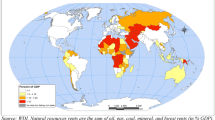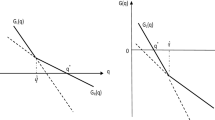Abstract
We present a model of Dutch disease in which revenue from natural resources is spent on the imports of intermediate and final goods. In the previous study of the Dutch disease model, the natural resources’ revenue is allocated only to the imports of final goods. We simulated Dutch disease according to Resource Movement Effect (RE) and Spending Effect (SE) in both primary and expanded models. The result shows that real appreciation is higher, and de-industrialization status is ambiguous if the revenue of natural resources is allocated to the imports of intermediate and final goods, and intermediate goods as an input in the production of the tradable sector. In other words, there is no guarantee that with the income of natural resources, a country will be industrialized. Real depreciation may occur if the natural resources revenue is invested in the non-tradable sector. The fluctuations of the real exchange rate in natural resource-rich countries are higher than in other countries when they are allocating revenue of natural resources to the imports of intermediate and final goods. This policy is more difficult for countries whose share of natural resources in GDP is more than 7%.











Similar content being viewed by others
Data availability
The datasets generated during the current study are available in: (1) World Integrated Trade Solution (WITS, 2018). Data files are available from: https://wits.worldbank.org/. (2) Darvas (2021) ‘Timely measurement of real effective exchange rates’, Working Paper, Bruegel, 23 December 2021. Available at: https://www.bruegel.org/publications/datasets/real-effective-exchange-rates-for-178-countries-a-new-database/. (3) World Development Indicator, World Bank (2020), Available at: https://databank.worldbank.org/reports.aspx?source=2&series=NY.GDP.MKTP.CD&country.
Notes
-The relative price of N is \(\frac{{P_{N} }}{{P_{T} }}\). This ratio is corresponding to the real exchange rate (Corden and Neary, 1982).
-It should be noted that in Eq. (5), parameter of = 0.5, this means that the intensity of labor and capital is the same.
- We have consider K = 10. K choice is voluntary. If we select K large, the number of correlated coefficients will be reduced.
- It should be noted that when > , we have RE > 0. SE is always positive irrespective of the size of the parameters.
References
Acemoglu D, Johnson S, Robinson J, Thaicharoen Y (2003) Institutional causes, macroeconomic symptoms: volatility, crises and growth. J Monet Econ 50(1):49–123
Anderson TL, Libecap GD (2005) Forging a new environmental and resource economics paradigm: the contractual bases for exchange. In: Workshop on Environmental Issues and New Institutional Economics, INRA-ENESAD CESAER,
Arrow KJ, Chenery HB, Minhas BS, Solow RM (1961) Capital-labor substitution and economic efficiency. Rev Econ Stat 43(3):225–250
Auty Richard M (1993) Sustaining Development in Mineral: The Resources Curse Thesis. Routledge, London
Badeeb RA, Lean HH, Clark J (2017) The evolution of the natural resource curse thesis: A critical literature survey. Resour Policy 51:123–134
Baumol WJ (1967) Macroeconomics of unbalanced growth: the anatomy of urban crisis. Am Econ Rev 57(3):415–426
Bems R (2008) Aggregate investment expenditures on tradable and nontradable goods. Rev Econ Dyn 11(4):852–883
Corden WM (1984) Booming sector and Dutch disease economics survey and consolidation. Oxford Econ Paper 36(3):359–380
Corden WM, Neary JP (1982) Booming sector and de-industrialization in a small open economy. Econ J 92:825–848
Darvas Z (2021) In: Timely measurement of real effective exchange rates. Bruegel Working Paper December, Brussels. https://www.econstor.eu/handle/10419/264201
David PA, Van de Klundert T (1965) Biased efficiency growth and capital-labor substitution in the US. Am Econ Rev 1:357–394
Eregha PB, Mesagan EP (2016) Oil resource abundance, institutions and growth: Evidence from oil producing African countries. Journal of Policy Modeling 38(3):603–619
EUKLEMS (2018) EU KLEMS Growth and Productivity Accounts: Statistical Module, ESA 2010 and ISIC Rev. 4 industry classification. Available from: https://euklems.eu
Fragiadakis K, Paroussos L, Kouvaritakis N, Capros P (2012) A multi–country econometric estimation of the constant elasticity of substitution. In: Final WIOD Conference: causes and consequences of globalization, groningen, The Netherlands. http://www.wiod.org/conferences/groningen/Paper_Fragiadakis_et_al.pdf
Gelb AH (1988) Oil windfalls: Blessing or curse? Oxford University Press
Ghavidel S, Narenji Sheshkalany A (2017) Cost disease in service sector. Serv Ind J 37(3–4):206–228
Goldar B, Pradhan BK, Sharma AK (2013) Elasticity of substitution between capital and labour inputs in manufacturing industries of the Indian economy. The Journal of Industrial Statistics 2:169–194
Gonzalez-Rozada M, Neumeyer PA (2003) The elasticity of substitution in demand for non-tradable goods in Latin America Case Study: Argentina. Universidad t. Di Tella Working Paper 13:27
Gylfason T, Herbertsson TT, Zoega G (1999) A mixed blessing: natural resources and economic growth. Macroecon Dyn 3(2):204–225
Gylfason T (2011) Natural resource endowment: A mixed blessing? Available at SSRN. https://doi.org/10.2139/ssrn.1766385
Herrendorf B, Herrington C, Valentinyi A (2015) Sectoral technology and structural transformation. Am Econ J Macroecon 7(4):104–133
Hodler R (2006) The curse of natural resources in fractionalized countries. Eur Econ Rev 50(6):1367–1386
International Labour Organization. (2020). ILOSTAT database [database]. Available from https://ilostat.ilo.org/data/.
Kakkar V, Yan IK (2011) Sectoral Capital-Labor Ratios and Total Factor Productivity: Evidence from Asia. Rev Int Econ 19(4):674–684
Kim DH, Lin SC (2017) Natural resources and economic development: new panel evidence. Environ Resource Econ 66(2):363–391
Knoblach M, Rößler M, Zwerschke P (2016) The elasticity of factor substitution between capital and labor in the US economy: a meta-regression analysis (No. 03/16). CEPIE Working Paper. https://www.econstor.eu/handle/10419/146770
Kravis IB, Heston A, Summers R (1982) World product and income: International comparisons of real gross product. The World Bank
León-Ledesma MA, McAdam P, Willman A (2010) Identifying the elasticity of substitution with biased technical change. American Economic Review 100(4):1330–1357
Lombardo G, Ravenna F (2012) The size of the tradable and non-tradable sectors: Evidence from input-output tables for 25 countries. Econ Lett 116(3):558–561
Lorenzo F, Aboal D, Osimani R (2005) The elasticity of substitution in demand for non-tradable goods in Uruguay. Inter-American Development Bank, Latin American Research Network
Mallick D (2012) The role of the elasticity of substitution in economic growth: A cross-country investigation. Labour Econ 19(5):682–694
Mehlum H, Moene K, Torvik R (2006) Institutions and the resource curse. Econ J 116(508):1–20
Mendoza EG (1992) The effects of macroeconomic shocks in a basic equilibrium framework. Staff Papers 39(4):855–889
Monga C, LIN JIY (2019) Structural transformation—overcoming the curse of destiny. The Oxford Handbook of Str Trans 6:1
Morshed AM, Turnovsky SJ (2004) Sectoral adjustment costs and real exchange rate dynamics in a two-sector dependent economy. J Int Econ 63(1):147–177
Ostry JD, Reinhart CM (1992) Private saving and terms of trade shocks: evidence from developing countries. Staff Papers 39(3):495–517
Papyrakis E, Gerlagh R (2004) The resource curse hypothesis and its transmission channels. J Comp Econ 32(1):181–193
Papyrakis E, Gerlagh R (2007) Resource abundance and economic growth in the United States. Eur Econ Rev 51(4):1011–1039
Pegg S (2010) Is there a Dutch disease in Botswana? Resour Policy 35(1):14–19
Ross ML (2007) How mineral-rich states can reduce inequality. Escaping Resource Curse 23775:237–255
Rostow WW, Rostow WW (1990) The stages of economic growth: A non-communist manifesto. Cambridge University Press, UK
Sachs J, Warner AM (1995) Natural Resources Abundance and economic growth. National bureau for Economic Research, Cambridge
Sachs JD, Warner AM (1997) Natural resource abundance and economic growth. Center for International Development and Harvard Institute for International Development, Cambridge
Sachs JD, Warner AM (1999) The big push, natural resource booms and growth. J Dev Econ 59(1):43–76
Sasaki H (2007) The rise of service employment and its impact on aggregate productivity growth. Struct Chang Econ Dyn 18(4):438–459
Stockman AC, Tesar LL (1995) Tastes and technology in a two-country model of the business cycle: explaining international comovements. American Eco Review 85(1):168–185
Takatsuka H, Zeng DZ, Zhao L (2015) Resource-based cities and the dutch disease. Res Energy Eco 40:57–84
Van der Ploeg F (2011) Natural resources: curse or blessing? J Eco Literature 49(2):366–420
Watkins MH (1963) A staple theory of economic growth. Canadian J Eco Political Sci Canadienne De Economiques Et Science Politique 29(2):141–158
World Integrated Trade Solution (WITS) (2018) Available at https://wits.worldbank.org/
World Bank (2020) World Development Indicators. https://databank.worldbank.org/source/world-development-indicators/preview/on
Acknowledgements
The authors are thankful to the respondents for their active participation in the survey and grateful to anonymous reviewers and the editor for their valuable suggestions to improve the quality of the paper.
Funding
This study has received no funding.
Author information
Authors and Affiliations
Contributions
The authors confirm responsibility for conceptualization, methodology, design, data curation, analysis, interpretation, writing, and review.
Corresponding author
Ethics declarations
Conflict of interest
All the authors declare that they have no conflict of interest.
Ethical approval
There is no ethical conflict.
Research involves human or animal participants
This article does not contain any studies with human participants or animals performed by any of the authors.
Consent to the publication
The authors give consent for the publication of the paper.
Supplementary Information
Below is the link to the electronic supplementary material.
Rights and permissions
Springer Nature or its licensor (e.g. a society or other partner) holds exclusive rights to this article under a publishing agreement with the author(s) or other rightsholder(s); author self-archiving of the accepted manuscript version of this article is solely governed by the terms of such publishing agreement and applicable law.
About this article
Cite this article
Ghavidel Doostkouei, S., Azizi, K. & Talaneh, A. Can natural resources revenue start industrialization? (A model for Dutch disease). SN Bus Econ 3, 22 (2023). https://doi.org/10.1007/s43546-022-00379-z
Received:
Accepted:
Published:
DOI: https://doi.org/10.1007/s43546-022-00379-z




